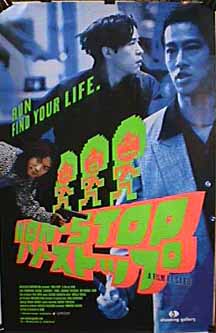Run dammit - - Nonstop (Danga ranna)
Genre: Action/comedy
Grade = B+
Japanese with english subtitles

This 1996 Japanese film and latest in the Shooting Gallery film series can be loosely described as a Japanese Run Lola Run. Written and directed by Hiroyuki Tanaka (a.k.a. the actor Sabu), the film showcases three men chasing each other for three very different reasons. Each has a very different background. Takeda (Shinichi Tsutsumi) is a low-level yakuza who is heartbroken when he fails to die to protect his boss. Aizawa (Diamond Yukai) is a heroin junkie and rock musician who has to make ends meet by working as a clerk in a convenience store. He owes a lot of money to Takeda for drugs. Yasuda (Tomoro Taguchi) has just been dumped by his girl and is treated like dirt by everyone at work. In order to improve himself, he decides to rob a bank.
The film opens with Yasuda carefully timing his bank robbery and get away. The next day he goes to rob the bank only to discover that he has forgotten to bring along his mask to disguise himself. He enters a convenience store and tries to shoplift a child's health mask only to be confronted by Aizawa who is working at the store. Aizawa plays it tough until Yasuda pulls his gun and accidently shoots him in the arm. Yasuda runs out of the shop. Aizawa picks up the gun and begins to chase him. They eventually run into Takeda (literally) who pulls a butcher knife out and begins to chase Aizawa. And so the movie goes, a running chase scene that lasts the length of the film intercut with flashbacks, daydreams and other scenes with yakuza intrigue.
Throughout the film we learn how the characters are actually interconnected with each other through the gun, money and drugs as well as each character's motivation, in a method simular to that of Lock, Stock and Two Smoking Barrels. The prime motivation for most of the chase is the Japanese cultural system of saving face. Each involves the characters trauma and treatment by others. It also involves their daydreams. In one of the most interesting scenes of the film, each of the runners pass a woman who is bending down to pickup something. Each sees her in a different sexual manner and each daydreams their own fantasy with her.
The story itself is mostly straightforward and usually understandable even though in a nonlinear format, however, the motivation of the characters could be lost on those that do not have an understanding of asian and Japanese culture. Particularly the notions of personal fulfillment and redemption through a person's own death. Although the story is itself interesting, it is not of the same quality of narrative as Run Lola Run.
The performances of the actors were adequate but not particularly outstanding. What was first-rate was the editing and direction. While the episodes of character development intercut with the running scenes could have been confusing, the editor and director managed to the make them interconnect fluidly. This is the kind of cohesiveness that the Hollywood editors and directors failed miserably to achieve in the action scenes of this years big budget flick Gladiator.
What is interesting enough about the film is how the characters actually use the run for self-actualization. This same theme was used about boxing in last year's Fight Club, and to it was as effective in this film as the run it used to define their lives. The ending itself is derivative of Reservoir Dogs but nonetheless the film is original in that it was made long before Run Lola Run.
This is the final film in a series foreign and independent films distributed this year by Shooting Gallery. Although you probably will not be able to catch it in the theater due to its short run at the theaters. You will probably be able to find it at Hollywood Video in the near future as they are the ones who distribute Shooting Gallery films.
Back to Ryanburg's Reel Reviews
The Intelligent Person's Guide to Anime
Ryanburg's Home Planet